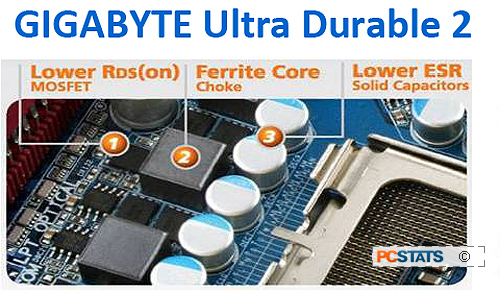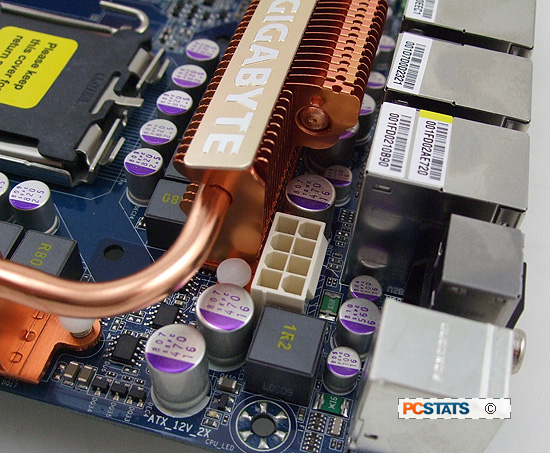Here's
how the Gigabyte EP45-DQ6 motherboard stacks up in real life against
a couple different motherboards. We have no way of directly
measuring motherboard power draw, so PCSTATS measures total system power
draw and compares that in CPU-loaded (max value recorded in Prime95) and
idle states (at Windows Vista desktop). An Extech 380803 AC Power Analyzer
and A-PFC
compliant
PC Power and Cooling 750W power supply were used
for these tests.
 System Power Draw Tests: (PCPower 750W
PSU) System Power Draw Tests: (PCPower 750W
PSU) |
| Desktop Idle (W) |
Points |
Ranking |
 Gigabyte GA-EP45-DQ6 (P45 333/1066) Gigabyte GA-EP45-DQ6 (P45 333/1066) |
145.5 |
   |
 Gigabyte GA-EP45-DQ6 (P45 333/1066) W/h Power Saving
ON Gigabyte GA-EP45-DQ6 (P45 333/1066) W/h Power Saving
ON |
142 |
   |
| ECS P45T-A (P45 333/800) |
146 |
   |
| Biostar TPower I45 (P45 333/1066) |
126.6 |
   |
| Prime95 Stressed (W) |
Points |
Ranking |
 Gigabyte GA-EP45-DQ6 (P45 333/1066) Gigabyte GA-EP45-DQ6 (P45 333/1066) |
197.7 |
   |
 Gigabyte GA-EP45-DQ6 (P45 333/1066) W/h
Power Saving ON Gigabyte GA-EP45-DQ6 (P45 333/1066) W/h
Power Saving ON |
189 |
   |
| ECS P45T-A (P45 333/800) |
196 |
   |
| Biostar TPower I45 (P45 333/1066) |
183.8 |
   | |
[*This
figure represents total system power consumption in Watts, either with the
system at idle, or the peak value recorded while running
Prime95.]
Really, neither PCSTATS testing or Gigabyte's software show dramatic
decreases in power draw when the Dynamic Energy Saver functions are
activated. At most it saved 3W - 8W depending on its
idle or stressed state fo the Core 2 Duo E6750 processor installed
into the EP45-DQ6 motherboard.. It is important to realize that even small power savings
like this accumulate over time, especially for users who leave their computers
on constantly, or for those living in regions where energy prices are high. When
it comes to entire offices and labs running many computers simultaneously,
having energy-efficient motherboards can shave a significant amount of money off
of yearly electricity costs.
Generally speaking, the power efficiency of a
motherboard is a small part of the whole equation, but it's one we're happy to
see computer manufacturers addressing more aggressively.
Ultra Durable 2 = better motherboards?
 Most mainstream and enthusiast grade
motherboards have migrated to all solid state capacitors. These electrical
components, along with ferrite core choke coils, Low RDS MOSFET's and
comprehensive passive cooling thermal solutions form the backbone of what
Gigabyte call Ultra Durable 2. The combination of all these
parts, according to Gigabyte, helps reduce temperatures, improve power
efficiency to the CPU and improve PC stability under load.
Most mainstream and enthusiast grade
motherboards have migrated to all solid state capacitors. These electrical
components, along with ferrite core choke coils, Low RDS MOSFET's and
comprehensive passive cooling thermal solutions form the backbone of what
Gigabyte call Ultra Durable 2. The combination of all these
parts, according to Gigabyte, helps reduce temperatures, improve power
efficiency to the CPU and improve PC stability under load.
You may or may not recall the problem of burst capacitors that turned into an industry wide
epidemic a few years ago. What caused poor quality electrolytic capacitors to
burst after ~3 years is a story of industrial espionage, stolen chemical
recipe's, and cut rate electronic components.
Consequently, the benefits of higher quality Japanese made electrolytic
capacitors, and conductive polymer solid-state aluminum capacitors has been
stressed on virtually every motherboard to have them since. Solid state
capacitors improve overall stability, and last significantly longer than the
electrolytic variety.
In the above slide are the three components of Gigabyte's Ultra Durable 2
approach. This is hardly a unique collection of electrical components, so it's
mainly significant because Gigabyte is making an effort to stress its build
quality over features. Shown here are the Ferrite Core choke coil (this helps
filter out EMI/RF interference), the LOW RDS(on) MOSFET (power circuitry), and
the 'All-Solid' aluminum Polymer capacitors.
|

Ultra Durable 2 uses solid
state capacitors, Ferrite Core chokes and low
RDS MOSFETs. The Gigabyte EP45-DQ6 motherboard has two power phases for both memory
and Intel P45 Express chipset, 12 power phases for the LGA775 processor.
|
Compared to standard Electrolytic capacitors which
use a fluid electrolyte, the 'all-solid' style aluminum polymer capacitor is
beneficial because it has a longer lifespan for the same given elevated
temperature that is common to the inside of a computer. As temperatures
increase, the lifespan of electrolytic capacitors begins to decline. The same
general rule of thumb holds true for MOSFETs as well, and according to
Gigabyte's information the LOW RD(on) variety can operate with decreased heat
output. A Ferrite Core RF Choke has high electronic resistance, better high
frequency operation, operates at a lower temperature, has reduced magnetic
leakage, and several other qualities Gigabyte engineers feel are desirable.
Next, PCSTATS examines the highlights of the Gigabyte EP45-DQ6 motherboard
itself. You'll want to have a good look at its silent chipset heatsinks...
